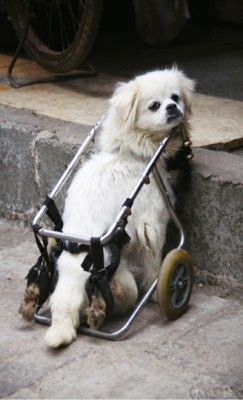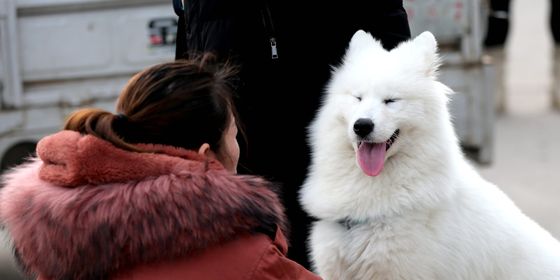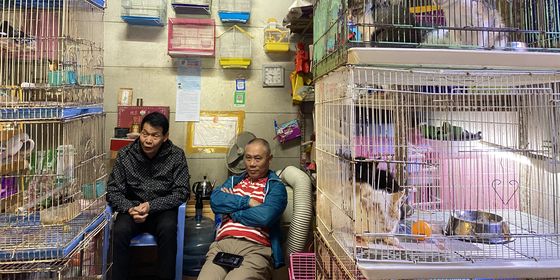Pet owners, the government, and the dogs themselves struggle with the responsibilities of pet ownership in the city
When you approach the iron gate of Laifu Yard, located in Dahuichang Village off the west Sixth Ring Road in Beijing, you are greeted by dozens of enthusiastic dogs—some with obvious disabilities—but they all look frantically happy to see any visitor. The gate is reinforced with boards, bars, and locks so that it’s not pushed open by the hyperactive canines. Though most of the dogs here have experienced pain and abandonment, they have no idea that the world outside the gate is still a hostile one.
Laifu Yard is in trouble. Founded in 1998 and one of the largest stray dog shelters in Beijing, the 0.4 acre yard now houses around 400 dogs and 200 cats, far beyond capacity. For several years, the villagers have been complaining about the noise and bad smell—quite reasonable considering households are in quite close proximity—and the complaints are coalescing into hatred. This year, the village committee is officially evicting Aunt Li, the founder of the shelter, and her dogs. Most NGOs concerned with stray animal welfare in Beijing, like Laifu Yard, are facing a similar situation: a shortage in funds, hands, and space. They keep moving farther from the city, all while taking on more and more animals from the careless metropolis.
In Chinese cities, the pet industry is advancing at a stunning speed. In 1993, there was only one brand of dog food in China, Mars; however, by 2014, the dog-care industry had boomed so rapidly that it is became a 900 million RMB a year venture.

A disabled and abandoned dog with two broken legs walks with the assistance of a device at the Society for the Prevention of Cruelty to Animals in Zhuhai, Guangdong Province, an NGO that adopts and cares for abandoned dogs and cats
However, much like many other industries, the pet industry is growing staggeringly and grotesquely, causing new problems along the way.
Like anything else, there have been trends in Chinese people’s preference of dog, trends often defined by popular films. Labradors became all the rage on Beijing’s streets in 2004 with Quill, and Lassie in 2006 made rough collies popular. Eight Below made Alaskan malamutes and huskies the most desired pets for a while, and shiba won the hearts of Chinese people in Hachiko: A Dog’s Story in 2009 (and of course the internet fame of Doge). However, as each trend came and went, Chinese dog owners realized that getting a dog is not exactly like inviting a friendly angel into your home; with each trend saw a new peak in abandonment for that breed.
“Those films are not truthful representations of the dogs,” Angella Zheng, companion animal project officer at the International Fund for Animal Welfare (IFAW), explains. “After the screening of Eight Below, a lot of people were lured into the fantasy that, if they didn’t own such a smart dog, they wouldn’t live the happy life of the film’s protagonist. However, you cannot really live a film. Huskies can howl like a wolf that resounds around the whole block if they are not given proper training. Alaskan malamutes are born to exercise extensively, and when they are confined to the limits of an urban apartment, their pent up energy may lead to extreme destructiveness.”
Currently, the Bichon Frise-Shih Tzu mix (Shichon) is the preferred breed in China, a small dog also known as a “teddy”.
“Although there have been various trends in the choice of dogs, it’s the first time one single breed has become this popular,” Doctor Yin from the Saijia Animal Hospital says. He has been practicing since 1998 and is one of the most acclaimed vets in Beijing. “Of course the phenomenon has its causes. The Shichon looks cute, and as a descendent of the poodle, it is also very intelligent. It doesn’t shed much hair, it’s small, and it is domestic by nature and doesn’t need to be walked a lot. In this respect, it’s almost perfect for Chinese urban residents in dense communities.”

A volunteer picks fleas from an abandoned dog with a missing eye at an animal protection NGO
However, Yin is concerned about the health of the dogs. “It’s a relatively newly-imported breed. Now that it has won Chinese people’s favor, it is multiplying in all Chinese dog breeding farms, but it is hard to tell the risks. It is already showing signs of hereditary diseases. Because of hip defects at birth, a lot of the Shichons I receive here suffer from necrosis of the hip joints. We will need to wait for another 10 or 15 years to see if it develops other hereditary defects.”
“There used to be more mongrel breeds in China,” Yin points out. “However, with the progress of urbanization and the dog breeding business becoming highly commercialized, most people purchase their dogs from markets instead of getting puppies from friends. Mostly, you can only see purebred dogs.”
Purebred dogs tend to have a much higher chance of hereditary diseases due to a lack of genetic diversity and inbreeding, and they are not as healthy as mongrels in general. While this is a fact all over the world, in China the situation is worse. “In China, the dog breeding business is extremely greedy. It is centered on self-interest only, instead of the dogs’ health,” Yin says. “That makes Chinese purebred dogs unhealthier than those abroad.”
“A Dog’s Life” is a feature story from our newest issue, “Military”. To read the whole piece, become a subscriber and receive the full magazine. Alternatively, you can purchase the digital version from the iTunes Store.












